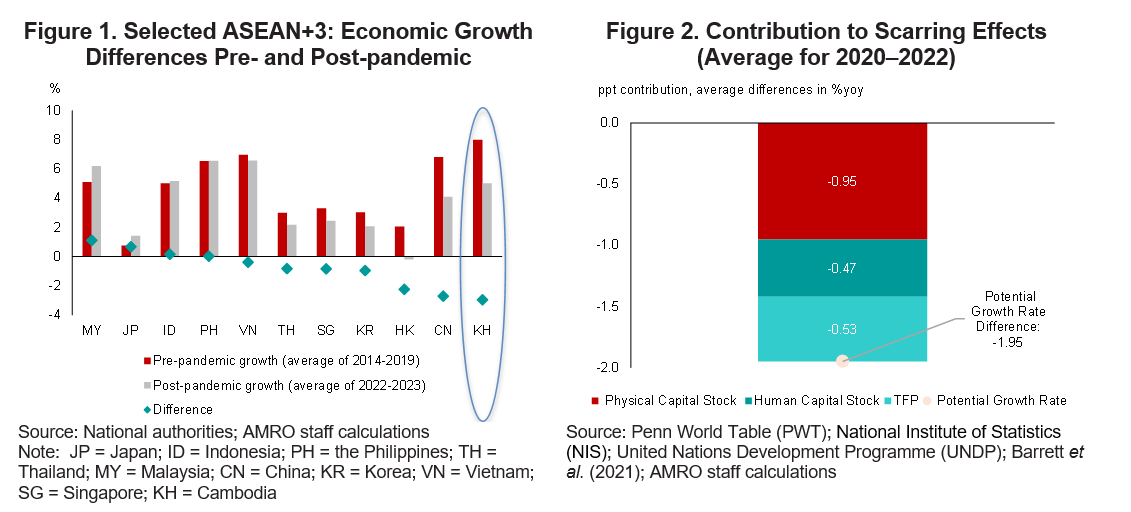This article first appeared in Khmer Times on November 12, 2024.
Cambodia’s economic growth significantly slowed in the wake of the COVID-19 pandemic. Before the pandemic, Cambodia grew at an impressive rate of 8 percent annually from 2011 to 2019. However, the growth rate fell to around 5 percent in 2022 – 2023, registering a slowdown larger than most regional peers (Figure 1).
The slower recovery partly reflects the scarring effects of the pandemic, which continue to drag Cambodia’s potential growth and prevent the economy from fully bouncing back. Identifying the sources of scarring effects can help shed light on the policy directions to improve long-term potential growth.

Sources of scarring effects
AMRO’s 2024 Annual Consultation Report on Cambodia showed that the pandemic scarring effects have reduced Cambodia’s potential growth by an average of 1.95 percentage points between 2020 and 2022. About half of the scarring effects in Cambodia were found to be attributable to lower growth in physical capital (─0.95 percentage points), with the remainder was due to weaker total factor productivity (TFP) and human capital (Figure 2).
The decline in TFP growth mainly reflected a temporary drop in labor productivity, under-utilization of firms’ resources, and efficiency losses. The accumulation in human capital slowed due to lower returns to education during the pandemic. Meanwhile, thanks to a stable labor market, the labor input factor did not dampen the country’s post-pandemic potential growth.
The pandemic has slowed the creation of physical capital stock, driven by a drop in investment, which only saw a sluggish recovery in recent years. The growth of foreign direct investments (FDI)—a major source of investment driving Cambodia’s growth over the past decades—slowed to 8.6 percent in 2020 and has stayed below 10 percent over the past two years versus over 10 percent before the pandemic.
Disruptions in face-to-face education have lowered the return to education and stalled the accumulation of Cambodia’s human capital stock. In rural areas where online learning was challenging, the workforce found it harder to gain skills needed for the post-pandemic economy. Such a gap in acquiring new skills poses a major concern for the country’s long-term productivity.
While employment growth remained stable and did not affect potential growth during the pandemic, the shift of workers to other sectors—compounded by deteriorating health conditions and reduced working hours— temporarily lowered labor productivity. Pandemic-related restrictions also led to under-utilization and misallocation of resources, resulting in efficiency losses.
Despite the temporary disruptions, the pandemic has also exposed and worsened some of Cambodia’s existing structural challenges. Limited adoption of new technologies, weak institutions, and a lack of economic diversification continue to set back the country’s growth trajectory.
Structural reforms for sustainable growth
Cambodia’s potential growth has declined since the pandemic due to reduced human capital formation—largely from disruptions in education—and lower fixed capital formation as a result of the impaired balance sheets of firms and a temporary drop in TFP.
To mitigate the scarring effects on its long-term growth potential, it is crucial to upgrade human capital through skill development and increasing physical capital by improving the investment climate.
With most workers educated only up to the primary level, the country should prioritize upskilling and reskilling the workforce through vocational education and on-the-job training. Expanding the Technical and Vocational Education and Training centers will help the workforce adapt to a digital and knowledge-based economy, thereby increasing the return to education.
Attracting foreign investment can bolster the accumulation of physical capital. The government should improve policies to promote foreign investment, ease market entry requirements, enhance economic efficiency, and ensure policy consistency to boost investor confidence.
Furthermore, growth potential and competitiveness can be enhanced through improvements in infrastructure development, digitalization, economic diversification, and reductions in logistics costs.
The Cambodian government has formulated a long-term development framework called the Pentagonal Strategy aimed at mitigating the pandemic scarring effects and promoting sustainable economic growth. The timely implementation of the structural reforms outlined in the strategy is essential.
